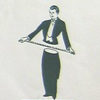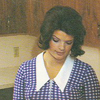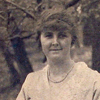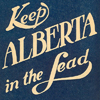“Historians and archaeologists will one day discover that the ads of our time are the richest and the most faithful reflections that any society ever made of its entire range of activities.”
– Marshall McLuhan (1911-1980), Canadian communications theorist.
 Welcome to PERSUASION, a digital exhibition examining examples of print advertising and advocacy produced by or directed at prairie Canadians over the past century. Welcome to PERSUASION, a digital exhibition examining examples of print advertising and advocacy produced by or directed at prairie Canadians over the past century.
 While not endorsing McLuhan’s fulsome claim, it is clear that advertisements are a popular resource for students interested in the histories of class, race, gender and sexuality in Canada. Ads are an excellent source for some factual information - e.g. the prices and availability of goods and services during particular periods. Their visual design and illustrations provide a flavor or ‘feel’ of past times especially prized by those preparing visual histories in either print or electronic formats. The reading and decoding of advertisements can reveal much about historical social structures and the acceptance or disputation of social attitudes and values. While not endorsing McLuhan’s fulsome claim, it is clear that advertisements are a popular resource for students interested in the histories of class, race, gender and sexuality in Canada. Ads are an excellent source for some factual information - e.g. the prices and availability of goods and services during particular periods. Their visual design and illustrations provide a flavor or ‘feel’ of past times especially prized by those preparing visual histories in either print or electronic formats. The reading and decoding of advertisements can reveal much about historical social structures and the acceptance or disputation of social attitudes and values.
 Like other primary historical documents advertisements must be examined critically. The analysis should include their context within the printed medium, their relationships to similar product ads, as well as a study of any information available about the advertiser, the publisher and the designers and illustrators. Advertisements can be a problematic source for documenting the reality of social and economic conditions since they may be more representative of consumers’ aspirations than reflective of the reality of their lives. Like other primary historical documents advertisements must be examined critically. The analysis should include their context within the printed medium, their relationships to similar product ads, as well as a study of any information available about the advertiser, the publisher and the designers and illustrators. Advertisements can be a problematic source for documenting the reality of social and economic conditions since they may be more representative of consumers’ aspirations than reflective of the reality of their lives.
 Consider what is not represented in advertising and what seems to be taken for granted. The portrayal of female experience is a popular interest. A cursory examination of early representations of women in advertising simply might suggest that women were all obsessed with the details of their domestic duties, the enhancement of their physical attractiveness and the comforting of a dominant male spouse. First Nations people are seldom represented in prairie advertising before the 1990s and when images do appear they are generally reflective of racial stereotypes. Only recently have Indigenous populations achieved the size and financial resources to become significant targets of interest to commercial advertisers. Consider what is not represented in advertising and what seems to be taken for granted. The portrayal of female experience is a popular interest. A cursory examination of early representations of women in advertising simply might suggest that women were all obsessed with the details of their domestic duties, the enhancement of their physical attractiveness and the comforting of a dominant male spouse. First Nations people are seldom represented in prairie advertising before the 1990s and when images do appear they are generally reflective of racial stereotypes. Only recently have Indigenous populations achieved the size and financial resources to become significant targets of interest to commercial advertisers.
PERSUASION has adopted a broad advertising definition – “the endeavor of an individual, business or organization to persuade others by means of a paid medium, to some specific act which will result in an advantage to those making the appeal.” The most ubiquitous form of advertising is commercial, aimed at persuading readers to purchase a good or service. Similar promotional strategies and formats are used by politicians seeking votes, and social activists and corporations seeking to influence public debates on a wide range of issues. The exhibition focuses on advocacy and advertising messages that employed a printed format. Until the introduction of commercial radio in the 1920s newspapers and magazines, posters and billboards, were the principal vehicles for advertising.
 Most of the advertisements in PERSUASION date from the first three quarters of the 20th century. An ad in the 1885 issue of the Regina Leader reporting on Louis Riel’s trial illustrates that advertising of a sort did exist before the waves of agricultural settlement that transformed the West in the early 20th century. Most of the advertisements in PERSUASION date from the first three quarters of the 20th century. An ad in the 1885 issue of the Regina Leader reporting on Louis Riel’s trial illustrates that advertising of a sort did exist before the waves of agricultural settlement that transformed the West in the early 20th century.
 The exhibits were drawn from the rich collections of the three sponsoring Saskatoon institutions – the Diefenbaker Canada Centre, the University of Saskatchewan Archives and the Special Collections Department of the University of Saskatchewan Library. Fortunately each of these collections is large and broad in scope and there was no difficulty selecting remarkable examples of promotion and advocacy produced in Manitoba and Alberta. Nonetheless items from Saskatchewan predominate and it was an early decision to use the exhibition as an introduction to some of the particular strengths and collecting interests of the sponsoring institutions. The exhibits were drawn from the rich collections of the three sponsoring Saskatoon institutions – the Diefenbaker Canada Centre, the University of Saskatchewan Archives and the Special Collections Department of the University of Saskatchewan Library. Fortunately each of these collections is large and broad in scope and there was no difficulty selecting remarkable examples of promotion and advocacy produced in Manitoba and Alberta. Nonetheless items from Saskatchewan predominate and it was an early decision to use the exhibition as an introduction to some of the particular strengths and collecting interests of the sponsoring institutions.
The exhibition begins with a brief examination of print formats employed in the past and present by effective advertisers. Most of the images of exhibits are presented within subject or theme galleries. To facilitate further study the exhibit includes an instructional component and a listing of recommended books and web resources. The exhibits may also be searched by print format, by date, and by keywords including added subject terms and geographic indicators.
|






